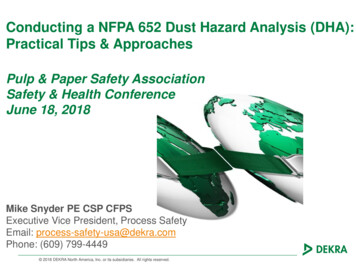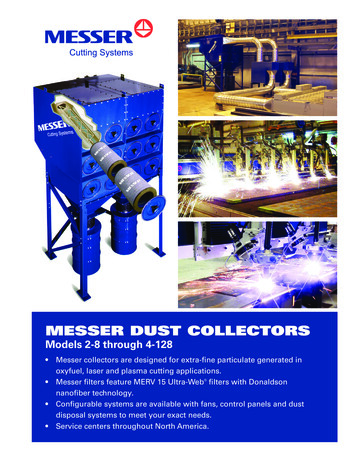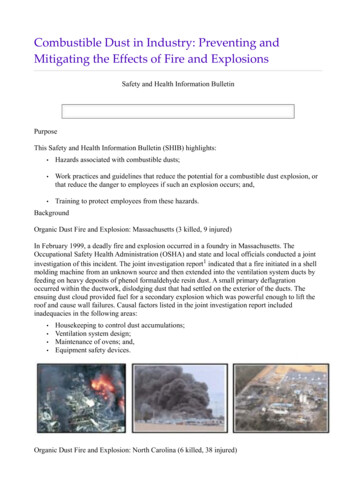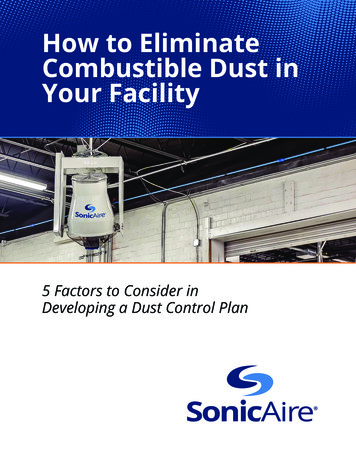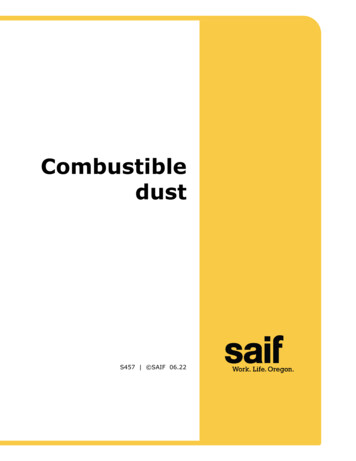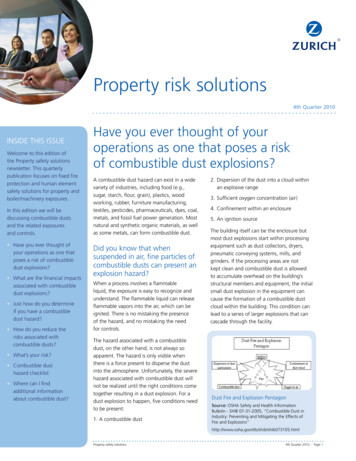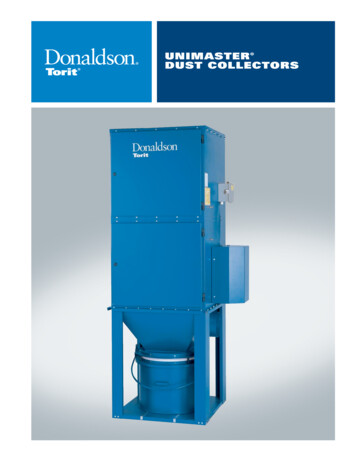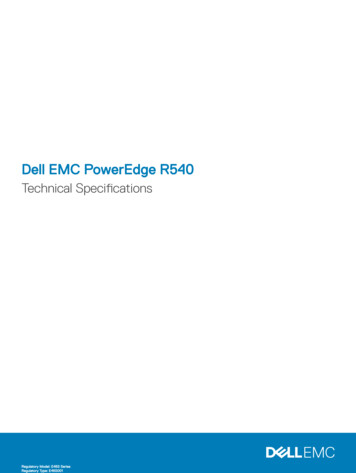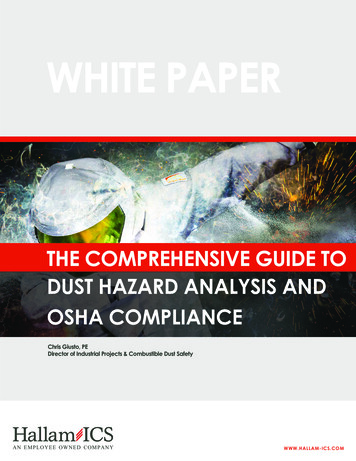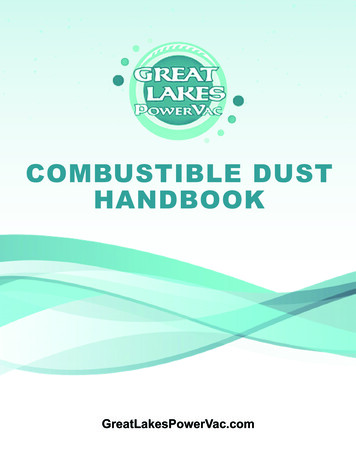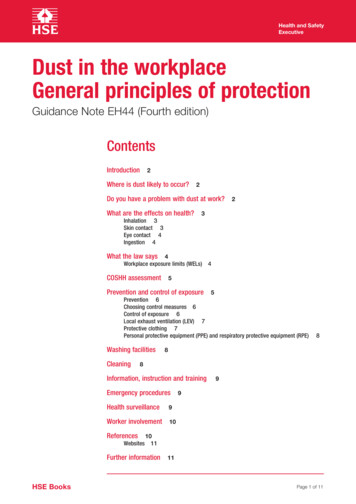
Transcription
Health and SafetyExecutiveDust in the workplaceGeneral principles of protectionGuidance Note EH44 (Fourth edition)ContentsIntroduction 2Where is dust likely to occur? 2Do you have a problem with dust at work? 2What are the effects on health? 3Inhalation 3Skin contact 3Eye contact 4Ingestion 4What the law says 4Workplace exposure limits (WELs) 4COSHH assessment 5Prevention and control of exposure 5Prevention 6Choosing control measures 6Control of exposure 6Local exhaust ventilation (LEV) 7Protective clothing 7Personal protective equipment (PPE) and respiratory protective equipment (RPE)Washing facilitiesCleaning888Information, instruction and training9Emergency procedures 9Health surveillance9Worker involvement 10References 10Websites 11Further information 11HSE BooksPage 1 of 11
Health and SafetyExecutiveIntroduction1This environmental hygiene guidance note describes how to control exposureto dust at work to avoid ill health. It will help you understand what you need to doto comply with the Control of Substances Hazardous to Health Regulations 2002(COSHH) and gives advice on the precautions that may be needed to prevent oradequately control exposure.2It does not deal with the fire or explosion hazards which some dusts present.Exposure to lead and asbestos and exposure to dust in mines is also not coveredin this guidance.3This guidance is aimed at employers and managers, but employees, healthand safety representatives and health and safety professionals may also find ituseful.Where is dust likely to occur?4Dust can be a problem in almost any industry. The hazards of dusts likesilica and wood are well recognised, and HSE produces specific guidance for thesedusts, but there are many more substances that generate dusts which arehazardous to health. Exposure to all such dusts needs to be prevented or, wherethis is not reasonably practicable, adequately controlled.Different forms of the same substance may present different hazards. A largepiece of a solid may present a negligible hazard, but when ground into a dust itmay become hazardous; wood and sandstone are obvious examples.5Many work activities can create dust. Some examples are: filling bags or emptying them into skips or other containers;weighing loose powders;cutting, eg paving stones;sieving and screening operations;conveying materials by mechanical means or by hand;stockpiling large volumes of processed materials;crushing and grading;milling, grinding, sanding down or other similar operations;cleaning and maintenance work;feeding livestock from bags or conveyor systems;clearing up spillages.Do you have a problem with dustat work?6Some simple checks may help in identifying whether a problem exists: Is the material naturally dusty?Does the work you do create dust by mechanical or other means?Is dust liable to be disturbed?Dust in the workplace: General principles of protectionPage 2 of 11
Health and SafetyExecutiveVisible dust on pipes, surfaces, ledges etc may indicate the presence of airbornedust. However, many dust particles are too fine to be visible under normal lightingconditions. A dust lamp, which provides a powerful beam of light, can be used asa quick method to show whether a fine dust is present, and helps to pinpoint thesources and movements of such dust. Further information on using dust lamps isavailable in The dust lamp MDHS82.What are the effects on health?7Exposure to any dust in excessive amounts can create respiratory problems.8The harmful effects of dust can vary, from skin irritation to lung cancer,depending on the composition of the dust and the type and degree of exposure.9Dust is not always an obvious hazard because the particles which cause themost damage are often invisible to the naked eye and the health effects ofexposure can take years to develop.Inhalation10 Dust that can enter the nose and mouth during breathing is referred to as‘total inhalable dust’. Some dust may consist of larger or heavier particles thattend to get trapped in the nose, mouth, throat or upper respiratory tract where theycan cause damage.11 Dust particles that are small enough to be breathed into the lungs are called‘respirable dusts’; these dusts can build up in the air spaces in the lungs and canlead to lung damage.12 The build up of any dust in the lungs could produce lung damage withinflammation and eventually fibrosis (scar tissue). This could lead to breathingimpairment. These conditions usually develop slowly, so symptoms may not appearuntil severe irreversible changes have taken place.13 Some dusts are well known for their ability to produce serious lung diseasesof this type, eg respirable crystalline silica (RCS) can cause silicosis and also lungcancer. Chronic effects of dust in the lungs are usually permanent and may bedisabling, so prevention of the onset of disease should be given the highest priority.14 Certain dusts, eg dusts from grain, flour, wood, reactive dyes and proteolyticenzymes are respiratory sensitisers which can cause occupational asthma (attacksof coughing; wheezing and chest tightness), rhinitis (runny or stuffy nose) andextrinsic allergic alveolitis (symptoms can include fever, cough, worseningbreathlessness and weight loss).Skin contact15 Some dusts can cause ulceration of the skin and irritation or skin sensitisationcan be caused by dusts such as epoxy resins, rubber processing chemicals, wooddust and fibreglass and can lead to dermatitis.Dust in the workplace: General principles of protectionPage 3 of 11
Health and SafetyExecutiveEye contact16 Dust particles produced during the cutting, grinding and drilling of materialscan cause eye damage/irritation, and some dusts may cause eye damage/irritationdue to their chemical nature.Ingestion17 Some inhaled dusts can become trapped in the mucus that lines therespiratory tract. This mucus tends to be either spat out or swallowed. Inhaleddusts can get into the digestive tract, where they can cause local effects such asgastrointestinal tract irritation. Alternatively, they can enter the bloodstream andproduce effects in other organs and tissues.Dusts may also find their way into the digestive tract via hand-to-mouth contactso ensure that employees maintain good standards of personal hygiene, andconsider whether eating and drinking should be prohibited in the workplace.What the law says18 Dust will be a ‘substance hazardous to health’ for the purposes of COSHH if itis a substance: which is listed in Table 3.2 of part 3 of Annex VI of the CLP Regulation; andfor which an indication of danger specified for the substance is very toxic,toxic, harmful, corrosive or irritant; orif it is a substance to which a workplace exposure limit (WEL) applies.19 If not falling within any of the above categories, paragraph (d) of the definitionof ‘substance hazardous to health’ in regulation 2 of COSHH states that any dustwhen present in the workplace at a concentration in air equal to or greater than10 mg/m3 of inhalable dust or 4 mg/m3 of respirable (as a time-weighted averageover an 8-hour period) is considered to be a substance hazardous to health.20 If the dust falls within the definition of ‘substance hazardous to health’ thenthe requirements of COSHH will apply, including the need to assess the risk toworkers and to ensure exposure is prevented or adequately controlled.Workplace exposure limits (WELs)21 Many substances that can create dust have been given a WEL underCOSHH.22 Not all dusty materials have a WEL; however, the lack of a limit does notmean that the substance is safe. Where dusts do not have a WEL but there isevidence of potential hazards to health, employers should consider setting theirown in-house standards, taking into account good control practice.23 Where dust contains components which have their own WELs, compliancewith all of the relevant individual limits is required.Dust in the workplace: General principles of protectionPage 4 of 11
Health and SafetyExecutiveCOSHH assessment24 The COSHH Regulations require employers to assess the risk to theiremployees, and to prevent or adequately control the exposure of employees tosubstances hazardous to health. You should: make a suitable and sufficient assessment of the risks to health from thedust(s) concerned and of the steps that need to be taken to meet therequirements of COSHH; andimplement those steps before the work begins.25 Sometimes air sampling may be needed to find out the level of exposure.These measurements should be made under normal working conditions and maybe supported by the observation of light scatter by using a dust lamp to detect anyless obvious escapes of very fine dust.26A risk assessment should include: an assessment of the risks to health from dust which should include:–– information on the hazardous nature of the dust;–– the type of exposure (inhalation, dermal or ingestion);–– how the exposure occurs;details of the controls to be used; andif appropriate, arrangements for emergency procedures. 27 If you employ five or more people, the significant findings of the assessmentmust be written down, along with the steps you are taking to prevent or controlexposure.28 Further information on risk assessment, sampling and emergency procedurescan be found in Control of substances hazardous to health: Approved Code ofPractice L5.Remember to review the assessment regularly to check that it is still valid,particularly if the task, processes or workers change.Prevention and control of exposure29 Never assume that any dust is safe. All uncontrolled dusts are potentiallyhazardous. In particular, any uncontrolled dry process or dusty work activity,especially in an enclosed environment, is likely to create a dust problem.30 However, dusts are not all equally hazardous. Different dusts or even thesame type of dust in different work situations may create different risks to healthand require different precautions to be taken. For example, different exposures arelikely to arise if the work activity takes place indoors or in the open air.Employers have a duty under COSHH to ensure that the exposure of employeesto substances hazardous to health is prevented or, if this is not reasonablypracticable, adequately controlled.Dust in the workplace: General principles of protectionPage 5 of 11
Health and SafetyExecutivePrevention31 Prevention of exposure to dust should be the first objective. Many forms ofdust can be eliminated from the workplace. Examples of how this can be doneinclude: eliminating dust by using special cutting techniques rather than by grinding orsawing, or by using wet-cutting processes;using less toxic materials, eg powdered alumina instead of flint or quartz as inthe pottery industry;using pellets rather than dusty powder;using dust-suppressed materials and emulsions or pastes rather than mixingdry constituents.Where substitute materials are used, employers need to ensure that these poseless of a health risk and that exposure is controlled in accordance with theprovisions of COSHH.Choosing control measures32 Control measures usually involve a combination of equipment and ways ofworking to reduce exposure. The right combination is crucial. No measures,however practical, can work unless they are used properly.33In order of priority the right combination of control measures could include:(a)(b)(c)(d)(e)(f)(g)Eliminate the use of a harmful product or substance and use a safer one.Use a safer form of the product, eg paste rather than powder.Change the process to emit less of the substance.Enclose the process so that dust does not escape.Extract dust emissions near the source.Minimise the number of workers that are at risk.Apply suitable administrative controls, such as reducing the length of time thatworkers are exposed to dust.Provide personal protective equipment (PPE) such as gloves, coveralls and arespirator. PPE must fit the wearer. The provision of PPE, if required, shouldbe in addition to the measures above, not instead of.(h)34 If your control measures include some combination of, (a) to (h) above, makesure that the controls all work together.Remember that PPE should only be considered as a control measure as a lastresort. Other control measures, such as reducing the emissions of dust at source,enclosing the source and removing the dust by effective local exhaust ventilation(LEV) should always be given first priority.Control of exposure35 Where it is not reasonably practicable to prevent exposure to dust, acombination of engineering and process controls may be appropriate. Theseinclude:Dust in the workplace: General principles of protectionPage 6 of 11
segregating or totally enclosing the potentially dusty processes to reduce thenumber of people exposed by:–– either making the process automatic; or–– providing means for remote operation or manipulation (eg a glove box).Some enclosures can be quite large (eg a shot blast enclosure), but it isusually necessary to allow access to the enclosure for essentialmaintenance work, in which case PPE may be required;providing extraction by LEV where total enclosure is not possible – examplesmay include:–– storage bins and hoppers;–– bucket elevators;–– conveyors;–– grinding mills;–– bag emptying operations;–– mixing machines;–– powder handling and packing processes;–– drum filling operations;using mechanical handling systems and closed containers;damping down materials where the process permits it, although such atechnique can itself generate dust if it is not used properly (however, wettingcannot be an effective method of controlling dust that is already airborne anddamp materials will become dusty again when the liquid evaporates);minimising the height that material is allowed to fall;enclosing materials storage areas, eg stockpiles – where this is not possible,wind erosion should be minimised by measures such as locating thestockpiles behind natural windbreaks;encouraging workers to work with care and instructing them how to controlthe dust produced by their work activities;maintaining a high standard of cleanliness;providing a good standard of ventilation;using a vacuum cleaner or a wet method to keep floors and surfaces cleanand to remove any spillages. Avoid using a compressed air line or drysweeping.Local exhaust ventilation (LEV)36 Local exhaust ventilation (LEV) systems should be built into, and speciallydesigned for, the machine or process that creates the dust. Remember that crossdraughts and general air movements can all detract from their efficiency.37 If you use LEV to control exposure, it needs regular checking and thoroughexamination and testing at least once every 14 months. Many people, eg engineersor insurance companies, can carry out thorough examination and testing of LEV.Whoever does the work must be competent, ie have the necessary skills,knowledge and experience. More information on LEV can be found in Controllingairborne contaminants at work HSG258.Protective clothing38 Protective clothing may be needed to prevent contamination of skin, hair orpersonal clothing. Work overalls should be kept separately from personal clothingand whenever possible these should be left at work, where arrangements shouldbe made for laundering them.Dust in the workplace: General principles of protectionPage 7 of 11
Personal protective equipment (PPE) and respiratoryprotective equipment (RPE)39 Personal protective equipment (PPE), which includes protective clothing andrespiratory protective equipment (RPE), may be provided for welfare purposes or toprotect other clothing. But its use as part of a strategy for controlling exposureshould only be considered when all other reasonably practicable measures havebeen taken and these have not, in themselves, achieved adequate control. RPEshould not be used as a substitute for good control. Further information on theselection and use of RPE can be found in the HSE publication Respiratoryprotective equipment at work: A practical guide HSG53.40 When considering PPE, the dust characteristics of the material need to betaken into account. Where PPE is used, a programme should be establishedcovering all aspects of its selection, use and maintenance. This includes facilities forworkers to change into their ordinary clothes and for PPE to be stored on site andregularly cleaned. It is important that any changing facilities are located at or nearthe area of dust contamination and that the facilities are designed to prevent thespread of contamination.41Further information on PPE and RPE can be found on the HSE website.To select the right RPE you will have to take account of the properties of thehazardous substances, the needs of the wearer, the work and workplaceconditions.Washing facilities42 Dusts can stick to employees’ clothing, hair and skin. Providing adequatewashing facilities means that dust can be removed before the employee leaves thejob. Whenever possible facilities should be easily accessible, and sited near thepoint of dust creation.43 The type of facilities provided will depend on the degree of contamination andthe type of dust. For many jobs a sink with warm water, liquid hand soap anddisposable towels might be all that is needed.Cleaning44 Where processes involving dusts are carried out, the building and plant shouldbe cleaned by a method that effectively removes accumulations of dust, but whichdoes not in itself give rise to airborne dust. The careful design of new buildings orplant can facilitate subsequent cleaning, for example avoiding ledges and poroussurfaces can make cleaning easier.45 You should not clean plant by brushing, compressed airline or any othermethod which disturbs the dust, such as dry sweeping, as once the dust hasbecome airborne the fine particles take a long time to settle.Dust in the workplace: General principles of protectionPage 8 of 11
Information, instruction and training46 You should provide your employees and other people on the premisessuitable and sufficient information, instruction and training. Don’t just hand them apage of written information. Examples of instruction and training include, asappropriate: making sure that workers understand the risks to health;showing workers how to use control measures properly, and how to checkthat they are working;carrying out practice drills for cleaning up spills safely – do this before anyspillages happen;if workers need to use RPE, they also need face fitting and appropriatetraining;if workers need to use protective gloves, they need to know how to put themon and take them off without contaminating their skin as well as correct skincare procedures including hand washing.Emergency procedures47 You need to plan and practice to cope with foreseeable accidents, incidentsor emergencies. This means: the right equipment to deal with the emergency (eg a spill), including protectiveequipment and decontamination products;the right procedures to deal with a casualty;the right people trained to take action;the right arrangements to deal with the waste created.Employers must provide suitable communication systems for warning employeeswho are liable to be affected by an accident, incident or emergency involvingsubstances hazardous to health. Think about how you would make informationavailable to the emergency services.Health surveillance48Health surveillance is appropriate in certain cases, for example where: employees are exposed to a dust linked to a particular disease or adversehealth effect; andthere is a reasonable likelihood under the conditions of work that the diseaseor adverse health effect might occur; andit is possible to detect the disease or adverse health effect and the techniqueof investigation is of low risk to the employee. 49For example, health surveillance will be appropriate where dusts may: produce systemic toxic effects, such as welding fume fever which affects thewhole body (eg exposures to certain metal dusts including arsenic, cobalt andcadmium);cause occupational asthma (eg wood, castor bean, halogeno-platinumcompounds); Dust in the workplace: General principles of protectionPage 9 of 11
cause dermatitis (eg dusts of nickel and chromium);cause cancer (eg respirable crystalline silica and hardwood dusts);cause pneumoconiosis (eg respirable crystalline silica).50Employees should be encouraged to: report any symptoms of dust-induced chest or skin disease, eg tightness ofbreath and skin rashes;be alert to spotting defects in dust control equipment and reporting them;ask for information about dust hazards if they are unsure. Further information on health surveillance can be found on the HSE website.Worker involvement51 Involve your workers in developing control measures to make sure they aresuitable for the way they carry out the work. Encourage them to suggestimprovements and to report anything they think might be going wrong. They mustbe made aware of the reasons for any health surveillance and be free to askquestions.ReferencesControl of substances hazardous to health (Fifth edition). The Control ofSubstances Hazardous to Health Regulations 2002 (as amended). Approved Codeof Practice and guidance L5 (Fifth edition) HSE Books 2005ISBN 978 0 7176 2981 7 www.hse.gov.uk/pubns/books/L5.htmControl of lead at work. Control of Lead at Work Regulations 2002. Approved Codeof Practice and guidance L132 (Third edition) HSE Books 2002ISBN 978 0 7176 2565 9 www.hse.gov.uk/pubns/books/L132.htmAsbestos: The analysts’ guide for sampling, analysis and clearance proceduresHSG248 HSE Books 2005 ISBN 978 0 7176 2875 9www.hse.gov.uk/pubns/books/hsg248.htmControlling airborne contaminants at work: A guide to local exhaust ventilation (LEV)HSG258 (Second edition) HSE Books 2011 ISBN 978 0 7176 6415 3www.hse.gov.uk/pubns/books/hsg258.htmA step by step guide to COSHH assessment HSG97 (Second edition) HSE Books2004 ISBN 978 0 7176 2785 1 www.hse.gov.uk/pubns/books/hsg97.htmEH40/2005 Workplace exposure limits: Containing the list of workplace exposurelimits for use with the Control of Substances Hazardous to Health Regulations (asamended) Environmental Hygiene Guidance Note EH40 (Second edition) HSEBooks 2011 ISBN 978 0 7176 6446 7 www.hse.gov.uk/pubns/books/eh40.htmRespiratory protective equipment at work: A practical guide HSG53 (Third edition)HSE Books 2005 ISBN 978 0 7176 2904 6www.hse.gov.uk/pubns/books/hsg53.htmMonitoring strategies for toxic substances HSG173 (Second edition) HSE Books2006 ISBN 978 0 7176 6188 6 www.hse.gov.uk/pubns/books/hsg173.htmDust in the workplace: General principles of protectionPage 10 of 11
Health and SafetyExecutiveConsulting employees on health and safety: A brief guide to the law LeafletINDG232(rev1) HSE Books 2008 www.hse.gov.uk/pubns/indg232.htmThe dust lamp: A simple tool for observing the presence of airborne particlesMDHS82 HSE Books 1997 ISBN 978 0 7176 1362 5www.hse.gov.uk/pubns/mdhs/Breathe freely: A workers’ information card on occupational asthma INDG172(rev1)HSE Books 2012 www.hse.gov.uk/pubns/indg172.htmRespiratory sensitisers and COSHH: Breathe freely – An employers’ leaflet onpreventing occupational asthma Leaflet INDG95(rev2) HSE Books 1995www.hse.gov.uk/pubns/indg95.htmAsthmagen? Critical assessments of the evidence for agents implicated inoccupational asthma HSE 2006 www.hse.gov.uk/asthma/asthmagen.pdfGeneral methods for sampling and gravimetric analysis of respirable and inhalabledust MDHS14/3 HSE Books 2000 ISBN 978 0 7176 1749 4www.hse.gov.uk/pubns/mdhs/Medical aspects of occupational skin disease Medical Guidance Note MS24 HSEBooks 1998 ISBN 978 0 7176 1545 2 equipment/index.htmHealth x.htmFurther informationFor information about health and safety, or to report inconsistencies or inaccuraciesin this guidance, visit www.hse.gov.uk/. You can view HSE guidance online andorder priced publications from the website. HSE priced publications are alsoavailable from bookshops.This guidance is issued by the Health and Safety Executive. Following the guidanceis not compulsory, unless specifically stated, and you are free to take other action.But if you do follow the guidance you will normally be doing enough to comply withthe law. Health and safety inspectors seek to secure compliance with the law andmay refer to this guidance.This document is available at: www.hse.gov.uk/pubns/eh44.htm. Crown copyright If you wish to reuse this information visitwww.hse.gov.uk/copyright.htm for details. First published 04/13.Published by the Health and Safety ExecutiveEH44 (Fourth edition)04/13Page 11 of 11
most damage are often invisible to the naked eye and the health effects of exposure can take years to develop. Inhalation 10 Dust that can enter the nose and mouth during breathing is referred to as 'total inhalable dust'. Some dust may consist of larger or heavier particles that
